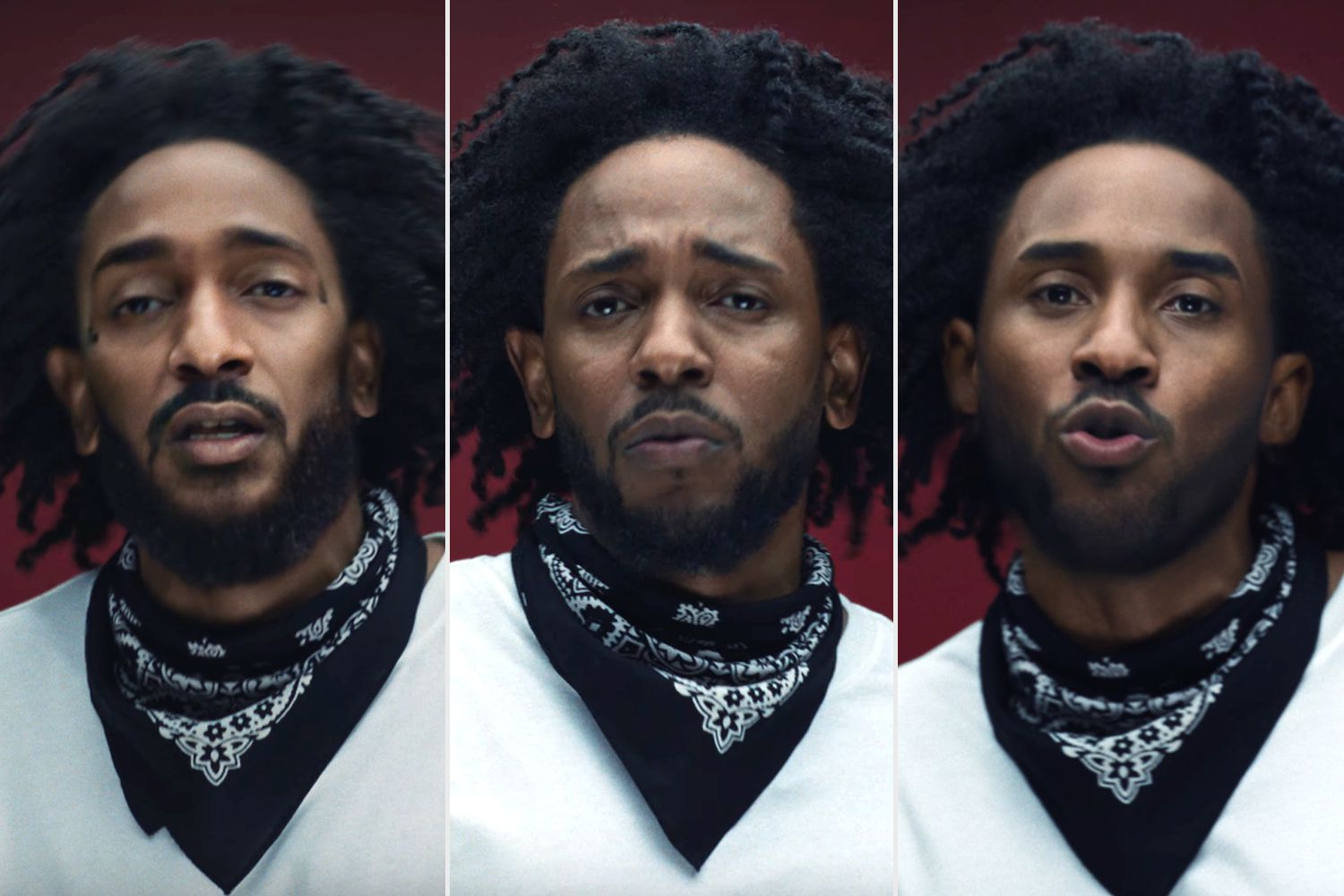Hope amidst oppression: A deep look into Kendrick Lamar’s “The Heart Part 5”
By Anton Karve
Quick Look:
[DISCLAIMER] The views presented below are one view on what Kendrick’s new song, “The Heart Part 5” is about. If you see things differently, drop a comment about your views! Part of the beauty of art lies in the ensuing discussion amongst the beholders.
On 8 May 2022, Kendrick Lamar dropped “The Heart Part 5”, and the hip-hop world snapped to attention. This was the Grammy and Pulitzer-prize winning rapper’s first single since his critically-acclaimed 2017 studio album “DAMN.”, and a new addition to Kendrick’s “The Heart” series always contains hints about his upcoming projects.
Here’s what fans have been saying on Twitter:
— DIO @ Offkai (@DoomSteve) May 9, 2022
When Kendrick Lamar turned into Nip and Kobe pic.twitter.com/0yGZcdjMXE
— Chris (@__chris22__) May 9, 2022
https://twitter.com/KingMosesDaGod/status/1523458869456158720?s=20&t=5oiWkXlaoHZw550dkmFDaQ
Notice how Kendrick Lamar is placed slightly on the left of the video (similar to where The Heart is located in the human body) and his constant bounce representing The Heart beat. ART. pic.twitter.com/nlLNejWZZ5
— Joey2.0 (@joeysnice) May 9, 2022
Kendrick Lamar came back after a 5 year hiatus continuing his The Heart series for his fans and making it over 5 minutes long without a moment wasted. The perfect rapper, idc.
— Dedee ? (@thoughtfulbae) May 9, 2022
"I am all of us" – oklama Kendrick Lamar pic.twitter.com/jILyRWIdl5
— Hiiipower – TDE News (@hiiipowers) May 9, 2022
Kendrick Lamar on the 3rd verse when he turn into Nipsey Hussle: pic.twitter.com/CwdZzUBNA9
— Man Of The Year (@ManOfTheYear808) May 9, 2022
The Song
The music video of “The Heart Part 5” begins with an ambiguous and unexplained quote,

“I am. All of us.” the opening quote from Kendrick Lamar’s “The Heart Part 5” music video. Image – Kendrick Lamar/Youtube.
Kendrick then cuts onto the screen, wearing a simple white shirt in front of a dark maroon background. He stares into the distance with a solemn, even pained expression upon his face, crossing his arms and clutching his shirt sleeves. A groovy backing track plays, featuring samples from Marvin Gaye’s sensual “I Want You”. A few bars later, Kendrick starts to speak:
“As I get a little older, I realize life is perspective
And my perspective may differ from yours”
Kendrick Lamar has been known to rap from the perspectives of different characters and alter-egos, and there are many examples of this. His 2012 studio album, “good kid, M.A.A.D city” features his ‘good kid’ persona, drifting through states of hopelessness, delirium, pain and rage.
In 2015, Kendrick appears to rap through his own personal perspective on “To Pimp A Butterfly”, delivering suave, confident bars over a variety of jazz and funk instrumentals.
Though it isn’t officially stated, it can be inferred from the above two quotes that Kendrick will likely be looking through the lens of a new character, “Oklama”, in “The Heart Part 5”.
“I come from a generation of pain, where murder is minor/
Rebellious and Margielas’ll chip you for designer/
Belt buckles and clout, overzealous if prone to violence/
Make the wrong turn, be it will or the wheel alignmentDesensitized, I vandalized pain, covered up and camouflaged/
Get used to hearin’ arsenal rain”
Through Oklama, Kendrick focuses heavily on issues such as cycles of violence, mass incarceration and institutionalised racism against black and brown minorities. Most of all, he laments on the gradual demonisation of “the culture”.
“Homies done f***ed your baby mama once you hit the yard, that’s culture/
Twenty-three hour lockdown, then somebody called/
Said your lil’ nephew was shot down, the culture’s involved/
I done seen n****s do seventeen, hit the halfway houseThat’s the culture, point the finger, promote ya/
Remote location, witness protection, they gon’ hold yaBut that’s the culture, crack a bottle/
Hard to deal with the pain when you’re soberIn the land where no equal is your equal/
Never say I ain’t told ya, nah/
In the land where hurt people hurt more people/
F*** callin’ it culture”
In the line “F*** callin’ it culture”, Kendrick (and/or Oklama) condemns the depiction of African-American culture as violent, vice-ridden and powerless to change their own circumstances.
“Get out and get his brains blown out, lookin’ to buy some weed/
Car wash is played out, new GoFundMe accounts’ll proceed/
A brand-new victim’ll shatter those dreams, the culture”
He signals at the necessity for oppressed communities to rise beyond their predicament and break the self-perpetuating cycle themselves, rather than relying on external parties such as government authorities or sympathetic donors to do so.
Besides “Oklama”, a character with fading hope that black and brown communities will overcome the shackles of “the culture”, Kendrick also raps from the perspective of several infamous celebrities. With a bodily jerk, he swipes his hands down his face and viewers are hit with a shock. Nothing else has changed, except viewers are now looking at the face of O.J. Simpson, uncannily superimposed onto Kendrick using deepfake technology.
Another jerk, and we now see deepfake Kanye West spitting lyrics that reference Ye’s bipolar disorder diagnosis. He also references issues about friends that take advantage of one’s deteriorating mental state for selfish personal gain.
“Friends bipolar, grab you by your pockets/
No option if you froze up, always play the offense”
Kendrick then transforms into Jussie Smollett, and raps about the hypocrisy of people that publicly condemn incidents where black people were killed, yet participate in black-on-black violence themselves.
“History repeats again/
Make amends, then find a n**** with the same skin to do it”
This line drips with irony, as Smollett infamously fabricated a racist and homophobic hate crime against himself in 2019 using two hired Nigerian men. Smollett did this with the purpose of framing and condemning Trump MAGA supporters, but Kendrick makes the point that regardless of the outcome, hypocritical acts only serve to delegitimize and downplay the importance of the real issues minorities face.
“Dehumanized, insensitive/
Scrutinize the way we live for you and I”
This line is delivered using the face of Will Smith, who experienced emotional turmoil in the past few years as his personal relationship issues were pulled to the surface and continuously scrutinised by the public.
“In the land where hurt people hurt more people/
Fuck callin’ it culture”
The scrutinization and dehumanisation came to a climax when Smith walked up on stage and slapped Chris Rock at the 2022 Academy Awards ceremony (“hurt people hurt more people”).
“Take the drums out”
The final forms Kendrick takes as he raps over a stripped-down beat are Kobe Bryant and Nipsey Hussle, two iconic black celebrities and philanthropists that were known to have extended strong and consistent effort to uplift their communities.

Kendrick Lamar (centre) deepfakes as the late Nipsey Hussle (left) and Kobe Bryant (right). Image – Kendrick Lamar/Youtube
“Sacrifice personal gain over everything/
Just to see the next generation better than ours”
Nipsey Hussle was murdered in 2019 outside the store he built for his community, while Kobe Bryant died in a helicopter crash on the way to a NBA game in 2020.
“Should I feel resentful I didn’t see my full potential?/
Should I feel regret about the good that I was into?/
Everything is everything, this ain’t coincidental/
I woke up that morning with more heart to give you/
As I bleed through the speakers, feel my presence”
In a heartbreaking turn, Kendrick raps the last section of the verse from the perspective of Nipsey Hussle, addressing his murderer as well as the family, friends and community he left behind.
“And to the killer that sped up my demise/
I forgive you, just know your soul’s in question/
I seen the pain in your pupil when that trigger had squeezed/
And though you did me gruesome, I was surely relievedAnd Sam, I’ll be watchin’ over you/
Make sure my kids watch all my interviews/
Make sure you live all the dreams we produce/
Keep that genius in your brain on the move/
And to my neighborhood, let the good prevail/
Make sure them babies and them leaders outta jail”
Though a risky and controversial choice to speak through the perspective of the dead, Kendrick does display respect towards Hussle’s legacy. From a personal perspective, Kendrick (and/or Oklama) accepts that those who partake in black-on-black violence carry their own pains that led them to this point. In this, he takes a ‘forgive, not forget’ standpoint. He expresses hope that despite the passing of such iconic black leaders, there is still potential for change.
“Look for salvation when troubles get real/
‘Cause you can’t help the world until you help yourself/
And I can’t blame the hood the day that I was killed/
Y’all had to see it, that’s the only way to feel/
And though my physical won’t reap the benefits/
The energy that carry on emits still”
Our Thoughts
Is an individual responsible for the state of their larger group, or is the group responsible for the state of the individual?
This is a layered question, exploring the relationship between individuals and their communities, as well as that between communities and the larger societies they are part of.
Kendrick clearly believes in the former, that individual communities must prioritise uplifting themselves rather than relying on external support of the larger society. Similarly, Kendrick takes a stance that the individual must first stay true to their values and morals before relying on neighbours to influence their decisions.
Are we products of our environment, or is it really the opposite?
There’s an argument for each side. After all, can we really expect oppressed minorities, chained down by a system that seeks to dehumanise and destroy their culture, to break the cycle of oppression themselves? During “The Heart Part 5” and throughout his discography, Kendrick Lamar has constantly reinforced his belief that they can.
Though I have not experienced the overbearing oppression black and brown minorities face in the US, as a member of a minority in my home country I can understand and agree with Kendrick’s sentiments. A change in perspective can only truly take place once the individual takes on personal accountability to ensure the change. The only one that can create the ideal circumstances for positive change is the individual themselves.
I believe we are products of our environment, but our future actions need not be bound by past traumas. In the end, the most important assets to have when facing impossible circumstances are hope for a better future, and the courage to actively move towards that future ourselves.
Our Review
Like the majority of his creative projects, Kendrick puts a vast amount of effort into the densely-packed “The Heart Part 5”. It is a song and music video absolutely dripping with symbolism, contextual meaning and emotion. Clever rhyme schemes and flow changes are expected for a Kendrick song, yet each new track he produces still feels unique and colourful. The funky, arousing Marvin Gaye-sampled beat contrasts the solemn, gut-punching lyrics, strongly increasing their effect but still making your head bounce to the rhythm.
The music video shocks viewers with the sudden deepfakes. They might initially seem like a cheap shot at the audience, but the meaning behind the different faces quickly becomes clear. All the faces shown belong to public figures that perpetuated society’s view of “the culture” in some way, shape or form.
The artwork for @KendrickLamar's 'The Heart Pt. 5' has some meaning behind it. pic.twitter.com/qP8nrxc1eX
— HipHop-N-More (@HipHopNMore) May 9, 2022
Deepfaking the late Kobe Bryant and Nipsey Hussle, and rapping from Hussle’s perspective could almost be seen as being done in bad taste, but given the context and meaning behind the song and video, it’s generally clear that Kendrick did so from a point of respect, not shock value.
Altogether, for a song and video that were meant to deliver Kendrick’s inner thoughts and generate hype for his upcoming album, “The Heart Part 5” accomplishes its goals incredibly well. I’d give it a solid overall 9/10. What did you think about the song?
Kendrick Lamar’s new studio album, “Mr. Morale & The Big Steppers“, releases 13 May, 2022.






















![Dr. Martens “Year of the Horse” collection [Release Date/Price/Where To Buy]](https://snkrdunk.s3.ap-northeast-1.amazonaws.com/en/magazine/wp-content/uploads/2025/12/26124817/20251226021918-0.jpg)

![Schott × Dickies® Collection [Release Date/Price/Where To Buy]](https://snkrdunk.s3.ap-northeast-1.amazonaws.com/en/magazine/wp-content/uploads/2025/12/26124241/20251226023256-0-scaled.webp)
![New Era®︎ × PlayStation Collection [Release Date/Price/Where To Buy]](https://snkrdunk.s3.ap-northeast-1.amazonaws.com/en/magazine/wp-content/uploads/2025/12/26123430/20251225074407-0.jpg)




